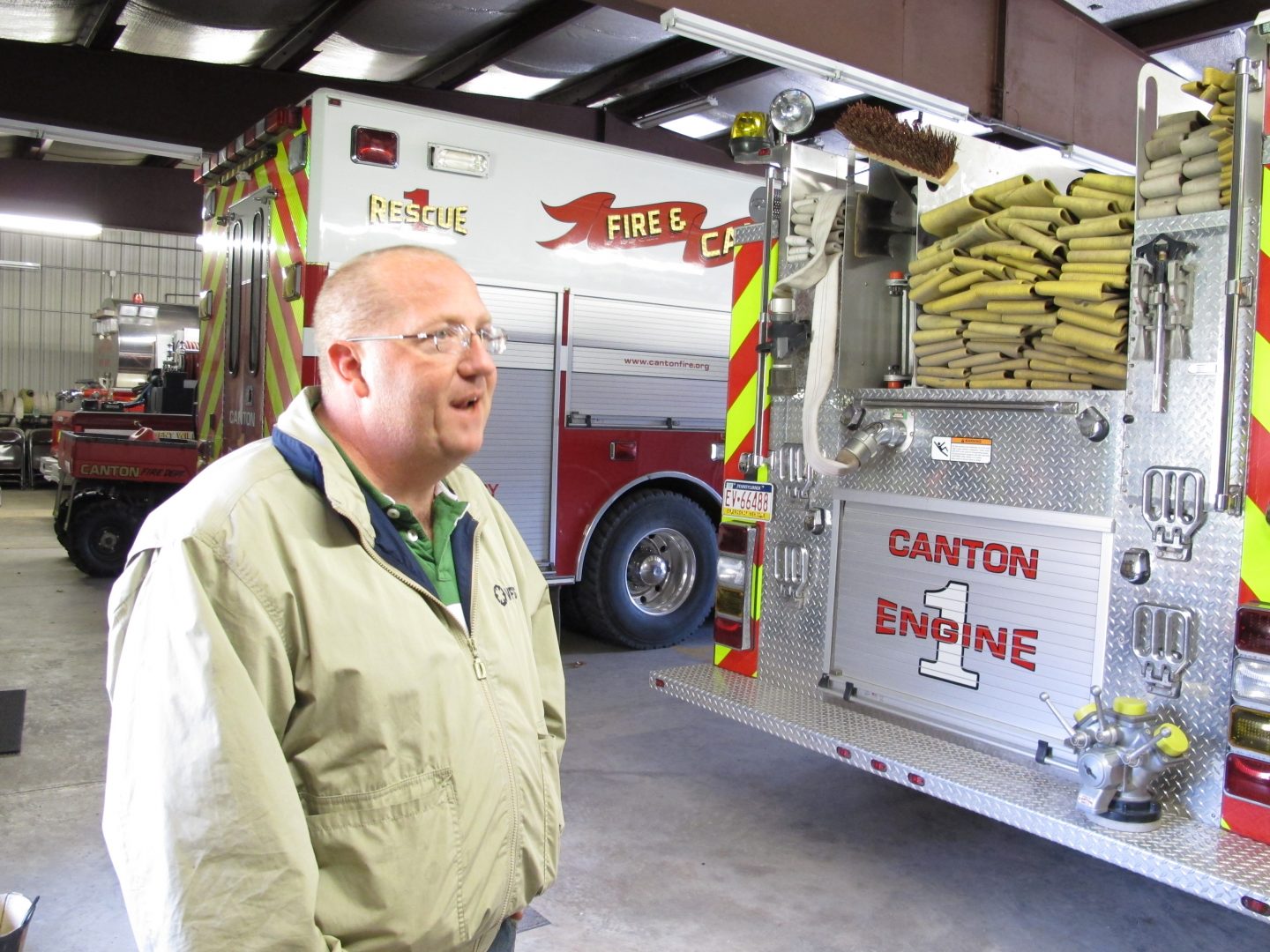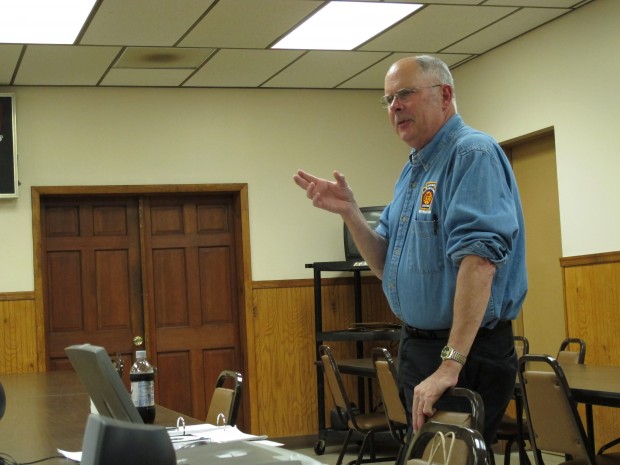
Canton Fire Chief Kim Jennings
Scott Detrow / StateImpact Pennsylvania


Canton Fire Chief Kim Jennings
Scott Detrow / StateImpact Pennsylvania

Scott Detrow / StateImpact Pennsylvania
Canton Fire Chief Kim Jennings

Scott Detrow / StateImpact Pennsylvania
Instructor Skip Roupp prepares Clinton County firefighters to respond to a natural gas well emergency
Talk to any emergency responder in a natural gas drilling-heavy area of Pennsylvania, and he’ll probably tell you it’s ‘only a matter of time’ before a Marcellus Shale well blows up.
Whether it’s the anticipated ‘big one,’ or day-to-day injuries on site, the natural gas boom is creating new challenges for firefighters. StateImpact Pennsylvania’s Scott Detrow looks at what the state Fire Commissioner’s Office is doing to prepare emergency responders for when the call arrives.
In Lock Haven, Clinton County, about 20 emergency responders are sitting in a fire hall, learning the details of how a natural gas well is “fracked.” A voiceover explains the details in a video, as muzak plays in the background: “It takes over 350 pieces of pipe, weighing nearly 87 tons, to drill a 10,500-foot well,” the voice explains.
The four-hour course is offered by the state fire commissioner’s office, and funded by a grant from the Marcellus Shale Coalition, which represents the drilling industry in Pennsylvania. It’s designed to teach firefighters the basics on what happens at a drilling pad, in case they ever need to respond to an emergency there.
In addition to drilling 101, instructor Skip Roupp lays out the dangers. “Again, hazards,” he says. “High pressure, high temperature gasses and liquids and hoses. Tripping over cables, hoses and pipes.”
Roupp — who works as Bradford County’s deputy emergency management director — stresses most of the calls that come from a well pad will be typical construction accidents. The major well fire, he says, is a one in a thousand event. “Which, living in Bradford County, scares the heck out of me, because we’re getting close to two thousand wells. So that means, if you follow that logic out, we’re due for a major blowout at some point.”
“It probably will happen,” he adds.
And when it does happen, the fire commissioner’s office has some interesting advice for firefighters. Roupp pauses to drive home the point: “You’re not going to put this fire out,” he tells the class.
Watch Roupp explain hazards firefighters may face at a natural gas well
Roupp says the job of shutting off a well spewing pressurized natural gas out of the ground will be left to the professionals, and State Fire Commissioner Ed Mann agrees. “If we have a blowout with fire, there’s no fire department in Pennsylvania that’s going to deal with or extinguish that fire. One of the wild well teams is going to be brought in to deal with that,” says Mann.
One of the few Pennsylvania fire chiefs who has experience working alongside these specialty well fire teams is Kim Jennings. He heads the Canton Fire Department in Bradford County, and led the response to the most high-profile Marcellus Shale accident yet – April’s a 10-thousand gallon fracking fluid spill at a Chesapeake Energy well in Leroy Township.
Jennings drove straight to the scene when he first got the call in the middle of the night. Either he or his assistant fire chief were on site throughout the next week.
The fire department focused on logistics: setting up a command post, getting equipment in place, and helping local residents evacuate their homes. They worked closely with Chesapeake, says Jennings. “We were talking with them, as to what evacuations or anything we were going to be doing. Everything was done very coordinated.”
Communication with the wild well team, Texas-based Boots and Coots, wasn’t as smooth. The team was late getting to the scene, and Jennings says he wasn’t sure what, exactly, they did. Going forward, state regulators will require wild well responders to keep a team in Pennsylvania, to cut back response time.
Jennings and his 30 active firefighters have taken the commissioner’s course. He says it helped in the Leroy spill, but adds experience is more important than classroom discussions. “There really isn’t a lot to prepare you yet for what you’re going to deal with on a day to day basis.”
Jennings guesses his department is about 75 percent prepared for a big fire, if it happens. He says more hands-on training would help. “Yes, we have had deadly incidents,” he explains. “We’ve had life-threatening incidents, and we’ve had a couple leaks. The only thing we’re really short is a fire.”
In the training class, instructor Skip Roupp stresses firefighters are much more likely to respond to those commonplace industrial accidents, than they are the big blowout. “Except for a few horrendous incidences, these are the normal things they face every day. It’s not anything particularly new.”
But it’s a first responder’s job to plan for the worst, and these regular training courses are one aspect of that preparation.
StateImpact Pennsylvania is a collaboration among WITF, WHYY, and the Allegheny Front. Reporters Reid Frazier, Rachel McDevitt and Susan Phillips cover the commonwealth’s energy economy. Read their reports on this site, and hear them on public radio stations across Pennsylvania.
(listed by story count)
StateImpact Pennsylvania is a collaboration among WITF, WHYY, and the Allegheny Front. Reporters Reid Frazier, Rachel McDevitt and Susan Phillips cover the commonwealth’s energy economy. Read their reports on this site, and hear them on public radio stations across Pennsylvania.
Climate Solutions, a collaboration of news organizations, educational institutions and a theater company, uses engagement, education and storytelling to help central Pennsylvanians toward climate change literacy, resilience and adaptation. Our work will amplify how people are finding solutions to the challenges presented by a warming world.